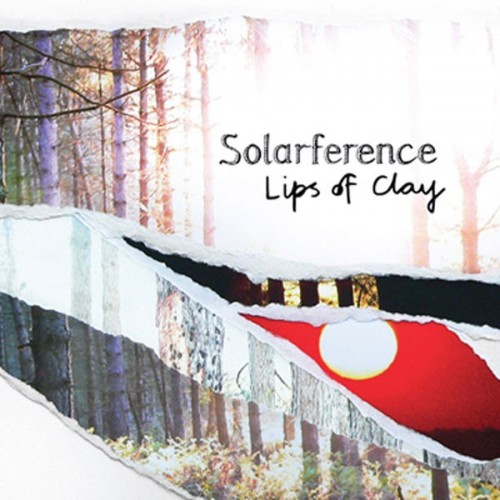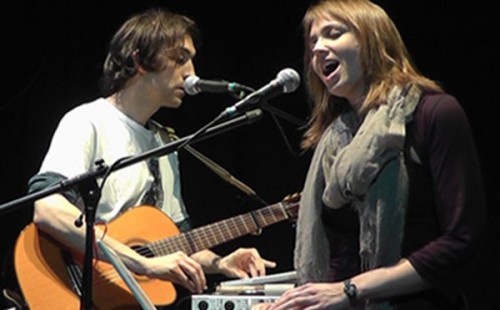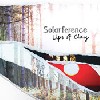Solarference - Lips of Clay
One Possible Face of Future Folk Music
By: David Wilson - Dec 09, 2012
Solarference
Lips of Clay
If Nick Janaway and Sarah Owen were to stand on stage and simply sing their repertoire of traditional ballads they would be noteworthy performers and develop a substantial following. Of that I have no doubt. Clearly unwilling to settle for something so mundane, they have set out to define a new performance milieu and have achieved substantial success in doing so.
By taking advantage of digital technology, i.e. laptops with sampling and sound processing software, they create a dramatic sound-scape envelope around their vocal performance that embellishes, hopefully enhances, the performance, fomenting several additional layers of emotional information.
This is not accompaniment in the traditional sense. Melody and harmonies save for rare moments are obtuse, rhythm is occasional but the sound elements are emotionally and sensorily linked to the material. It is accompaniment in the sense that the performers are not limited to the studio, but can bring their art to any venue or stage with a lot less set-up than most small bands. Most important of all, it permits improvisation, immediate and constant mid performance reinterpretation. At this point in the evolution, techniques to create tension far outpace those that offer resolution.
Historically they are hardly the first, and a case could probably be made for the earliest electric guitar distortions as precedent. In the late ‘60s Joseph Byrd and his seminal group The United States of America used custom built synthesizers to produce an album in many ways kin to Lips of Clay. Byrd paved the way for a lot of the electronic pop and rock that followed. Beaver & Krause with their early blending of natural sounds and Moog synthesizer laid another paving stone on this path, and of course, studio productions with now ever-present digital processors incorporate all sorts of previously un-producible sounds.
In traditional music, any incorporation of technology is much trickier. Such intrusion, by itself, obviates the very nature of the genre. A number of solo contemporary acoustic performers who nonetheless use amplification in performance do make use of sampling and playback as, for example, a way to add harmonies to their choruses. The Carolina Chocolate Drops are notable for their seamless use of Beat Box into some of their traditional string band tunes.
For all that, traditional ballads, the meat and potatoes of Solarference, are as much literary forms as they are musical. They report a happening, real or fictional. For centuries, minstrels and bards shaped the forms emphasizing imagery over description to transmit the story. The consistency of the form permitted ritualized dancing as an embellishment to the tale though, often enough, I am sure, the ballad became the embellishment of the dance. Percussion likely started with the stamping of feet in the dance, while accompaniment with musical instruments is relatively recent.
Solarference, rather than modifying the ballad, broadens and maybe even transfigures the form itself, with their addition of audio imagery. This is both the very strength and weakness of their creation.
Acceptance and appreciation of any art-form has as much to do with expectation and familiarity as it does with intent. The lack of a common or more universal vocabulary of audio imagery is a major obstacle to experiencing and understanding any performance and will disappoint or alienate many an audience. In the case of Solarference, this is ameliorated by strong vocal performances and stalwart time-tested material which provides safe anchorage for our aesthetic sensibilities while we allow ourselves to experience additional aspects.
I personally would like to hear a greater incorporation of natural sounds, those Bernie Krause defines in his seminal “The Great Animal Orchestra,” as geophony; wind, water etc. and biophony; animal and vegetable. For newbie listeners this would provide more of the common or universal vocabulary mentioned above.
With all the above said, from the first casual listening of this CD, I was drawn in and repeated listening constantly increases the fascination I find with the artistry of Nick and Sarah. About the individual songs, I will not comment, preferring to let you use the provided links to make your own decisions.
I am admittedly, already a fan, and eagerly wait to see and hear what they might come up with next and whether or not what they have produced will inspire other musicians to adopt, adapt and add to the form. I hope and suspect it will be a fruitful process.
An interview with Solarference by David Kushar
Cold Blows The Wind
Lucy Wan





